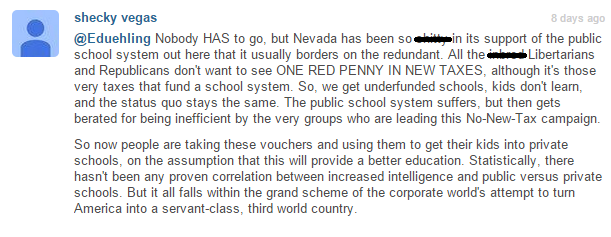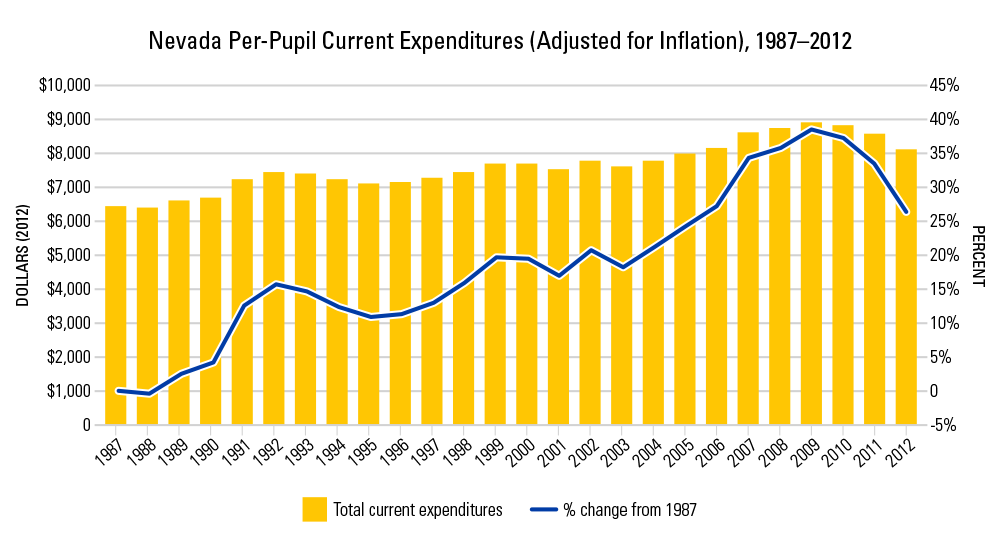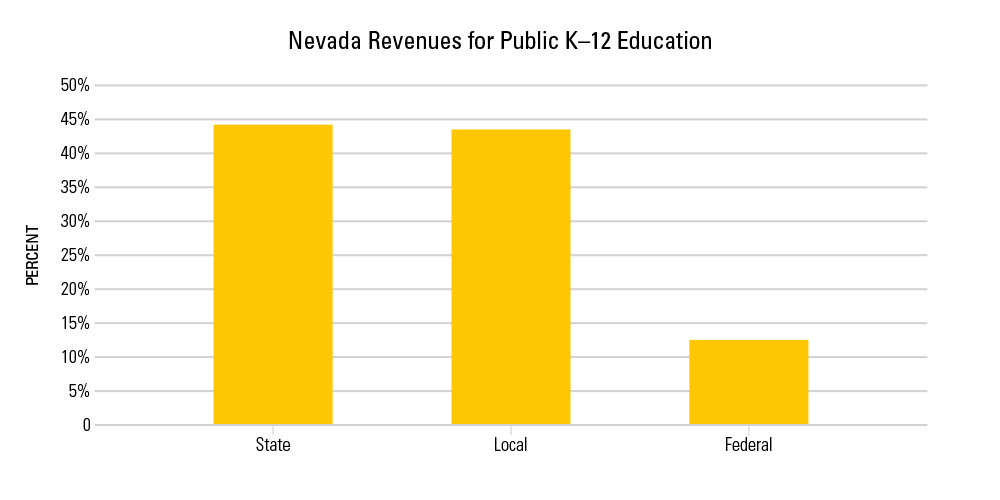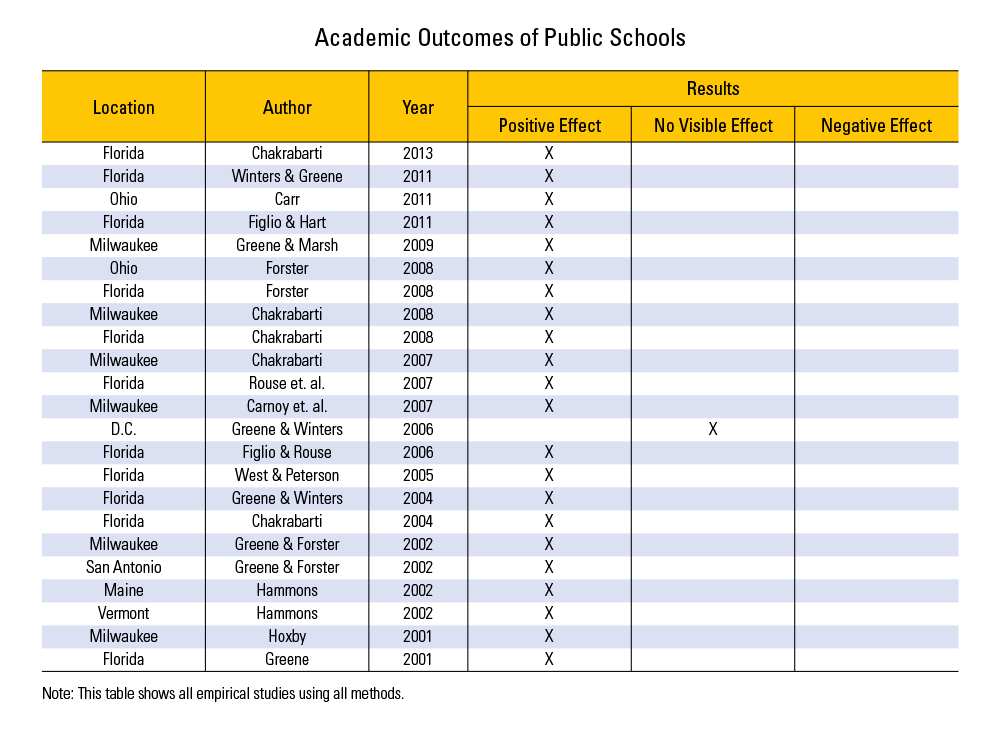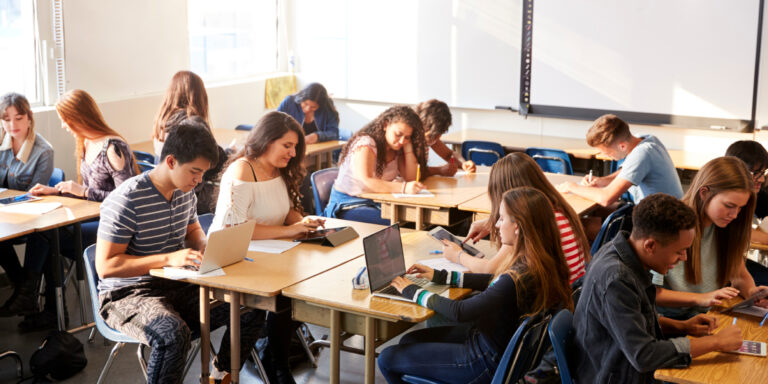Friday Freakout: The Truth About Nevada’s Education Spending
As media coverage of Nevada’s new education savings account (ESA) program booms, so do online comments—both in support of and against the innovative new school choice program. A recent Las Vegas Sun article drew plenty from both sides.
We think one response from this commenter deserves a reply:
Harsh language aside, shecky vegas combines three arguments that we often hear from school choice opponents. We’ll examine the validity of each in today’s freakout.
1. School choice proponents don’t support Nevada public schools.
The commenter first argues school choice proponents don’t support public schools, and neither would one support raising taxes to increase funding for education. It’s a classic argument that pits the parent-pleasing utility of school choice programs against the wellbeing of the public school system. And, once again, it’s a false dichotomy.
Nevada itself is a case in point. Yes, Gov. Brian Sandoval, a member of the Republican party, signed the nation’s first nearly universal ESA bill into law on May 29, 2015. But just two weeks later, Gov. Sandoval also signed Senate Bills 508 and 515. The former updates Nevada’s public school funding formula, and the latter increases public school funding by more than $300 million over two years—by raising taxes.
Clearly, Gov. Sandoval and the Nevada legislature have prioritized both school choice and public schools in 2015. What matters most is funding every single child, not just those who want to enroll in government-run public schools.
2. Nevada public schools have never been properly funded, and ESAs will drain them further.
Now to address the second part of shecky vegas’s worries about the Nevada public school system: that the schools are historically “underfunded.”
How one defines “underfunded” is an important point to consider. If “underfunded” is defined by the comparison of Nevada’s education spending to other states, shecky vegas might not be totally out of bounds. Nevada does rank 46th in the nation in overall school spending per pupil. But most would argue that definition isn’t accurate. Should “the most spending” be synonymous with “the right amount of spending”? We don’t think so.
We would argue that—to determine whether children are getting the right amount of education funding—the system must be structured in such a way that schools in the education marketplace (which exists, like it or not) can reach a balance point between supply and demand. For that to work, every student must have the same freedom to move from school to school, sector to sector to find the school and price that fit their needs. That’s why universal school choice matters.
But despite that philosophy, we must address shecky vegas’s claim that Nevada has a track record of not financially supporting public schools.
Like many other states, Nevada’s public school spending has ebbed and flowed since the 80s, while maintaining an upward trend overall. The Great Recession began around December of 2007, and as US Department of Education data show, Nevada’s education spending continued to increase despite an economic recession. It wasn’t until a few years later in 2009 that Nevada finally began to see a decline in spending.
Source: U.S. Department of Education, National Center for Education Statistics, ElSi, https://nces.ed.gov/ccd/elsi/
With the state of the economy during that time, there’s no surprise the Nevada legislature tightened its purse strings accordingly.
In response to this data, some, like shecky vegas, still might allude to the new ESA program as draining even more funding away from public schools. That assertion, however, belies a misunderstanding of how the ESA program is funded.
The state’s public education revenues are broken down like this, according to the 2015 Nevada Plan for School Finance by the Fiscal Analysis Division of the Nevada Legislative Counsel Bureau:
The ESA program will give middle- and high-income participants around $5,100 of only their state per-pupil education funds. That’s 90 percent of the 2016 estimated statewide average basic support. (Low-income students and students with special needs will receive 100 percent.)
Big picture, that would leave public schools with 10 percent of the basic state funding—around $566—for students that they aren’t actually educating in their schools. Plus, public schools also would be left with all local and federal per-pupil revenue.
For instance, we can underestimate how many dollars Nevada public schools might keep per ESA student by using the most recent revenue data available from the US Department of Education (2012). What we find is—even at significantly lower 2012 funding levels and proportionally larger 2016 ESA amounts—public schools would still retain a significant amount of money for children who might leave using the program.
Here’s how the math would shake out for one Clark County ESA student in that scenario:
3. Private schools aren’t any better than public schools, anyway.
Finally, shecky vegas makes the argument that “[statistically], there hasn’t been any proven correlation between increased intelligence and public versus private schools.”
Technically, that is true, as researchers are always hesitant to assign correlation and causation. Neither are we aware of research examining the relationship between schooling sector and children’s IQ scores. People have also debated whether people’s IQs change. But undoubtedly, with a good education, every child will become more knowledgeable. Test scores are just one way researchers can measure children’s knowledge of subject matter.
Eleven of 12 studies show—with all other variables controlled—private school choice programs do result in better academic outcomes for the students who use them. The worst result any study has shown is a neutral effect. However, that’s not to say 1. school choice didn’t have an affect on other aspects of those students’ educational experience or 2. that those students’ public schools couldn’t do wonders for other children. No randomized control trial has ever shown children’s academic abilities decline because of school choice.
Greg Forster’s A Win-Win Solution: The Empirical Evidence on School Choice synthesizes those 12 studies as well as 23 empirical studies that examine the competitive effects of school choice programs on the academic performance of students “left behind” in public schools. Here’s a quick review of the findings from those studies:
It’s clear the available evidence shows school choice programs tend to benefit participants without harming the performance of students in surrounding public schools, oftentimes even improving those outcomes. On top of that, ESAs are a fiscally sound policy for taxpayers.
The bottom line, though, is that school choice programs are not a “…grand scheme of the corporate world’s attempt to turn America into a servant-class, third world country.” They’re not even about pulling all kids everywhere out of public schools and into the private school sector. School choice is ultimately about allowing each family to find the best possible educational fit for their unique children. For some kids, that means attending a great public school in their neighborhood. For others, it means full-time private schooling, online learning, specialized tutoring, or a combination of options.


